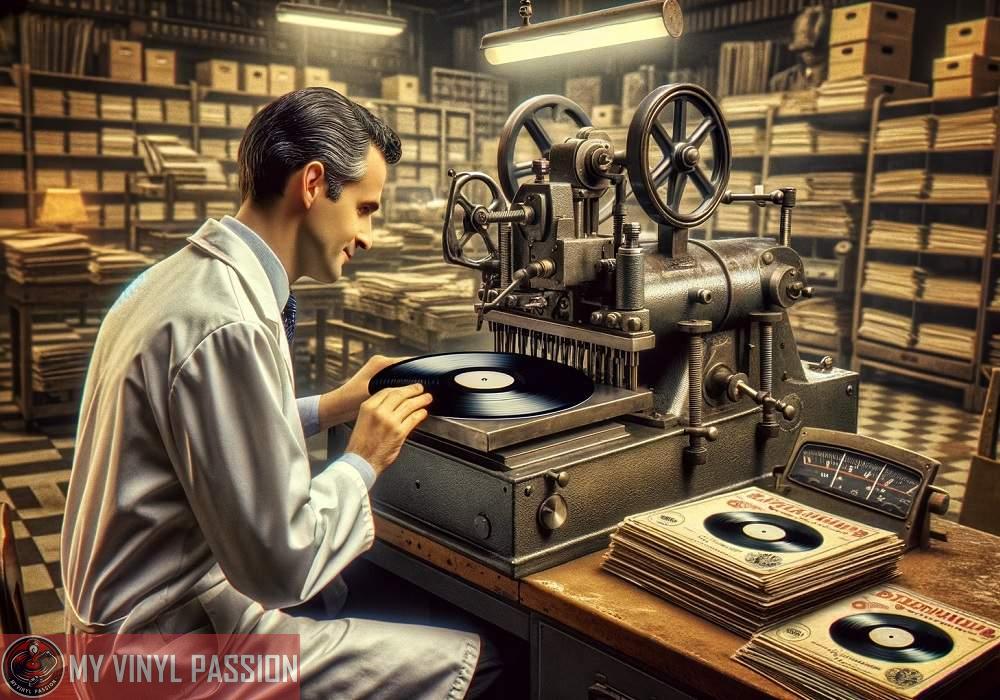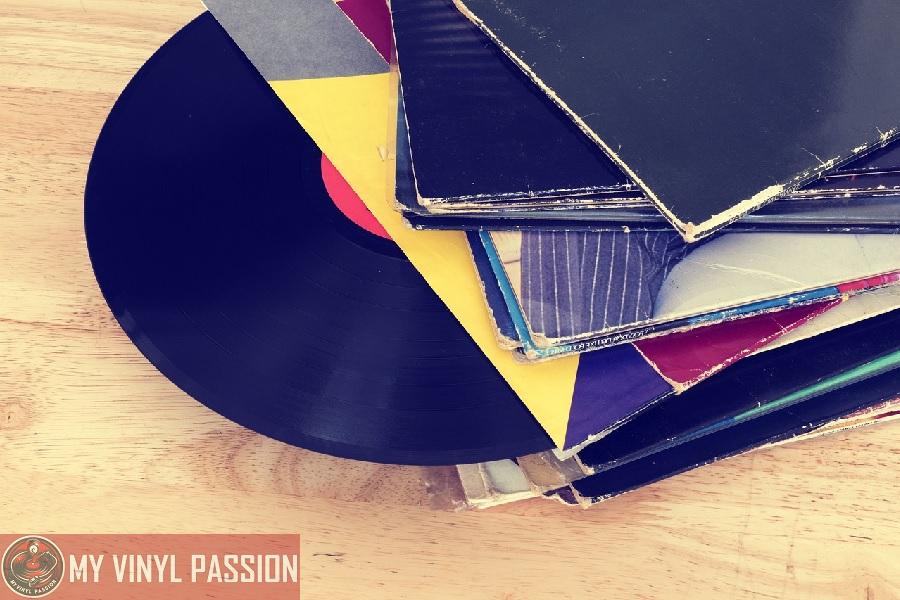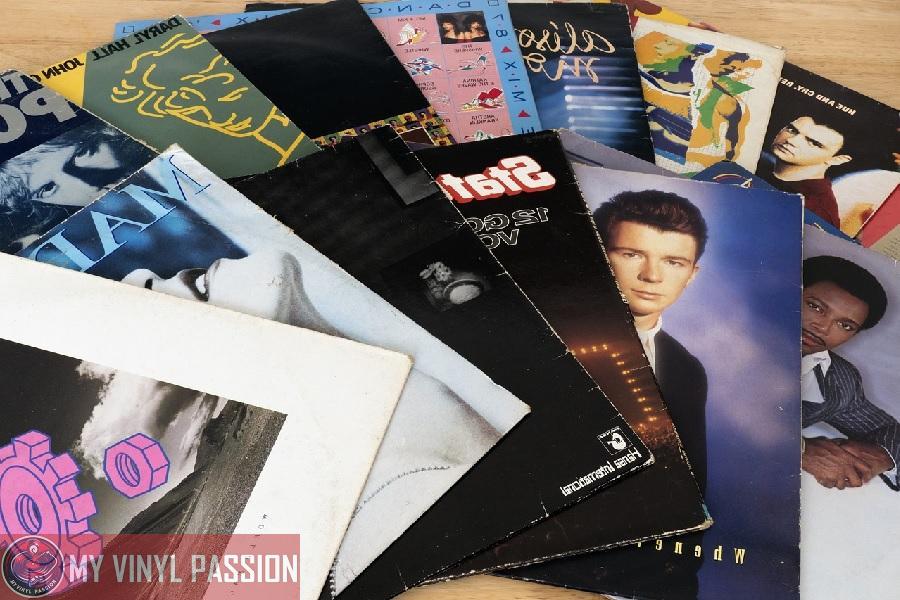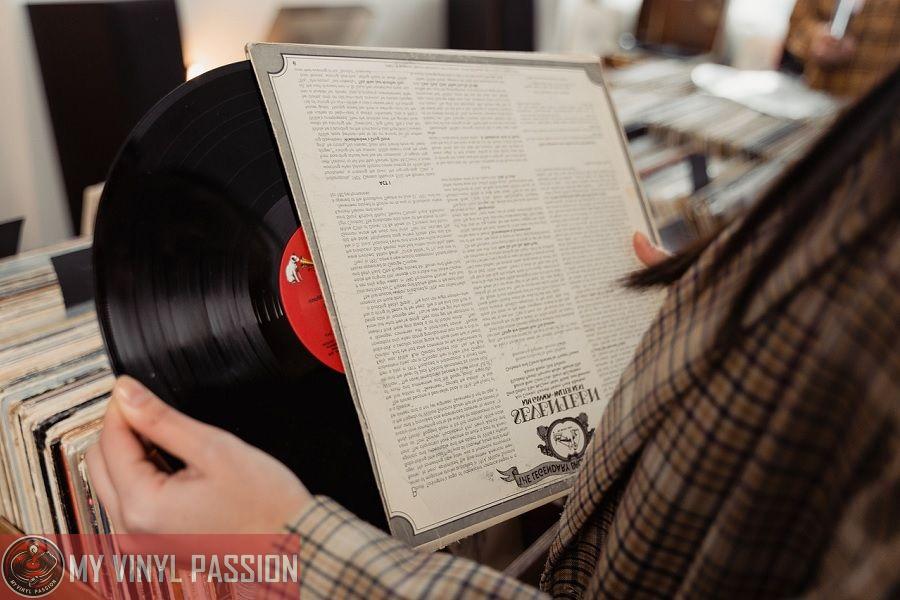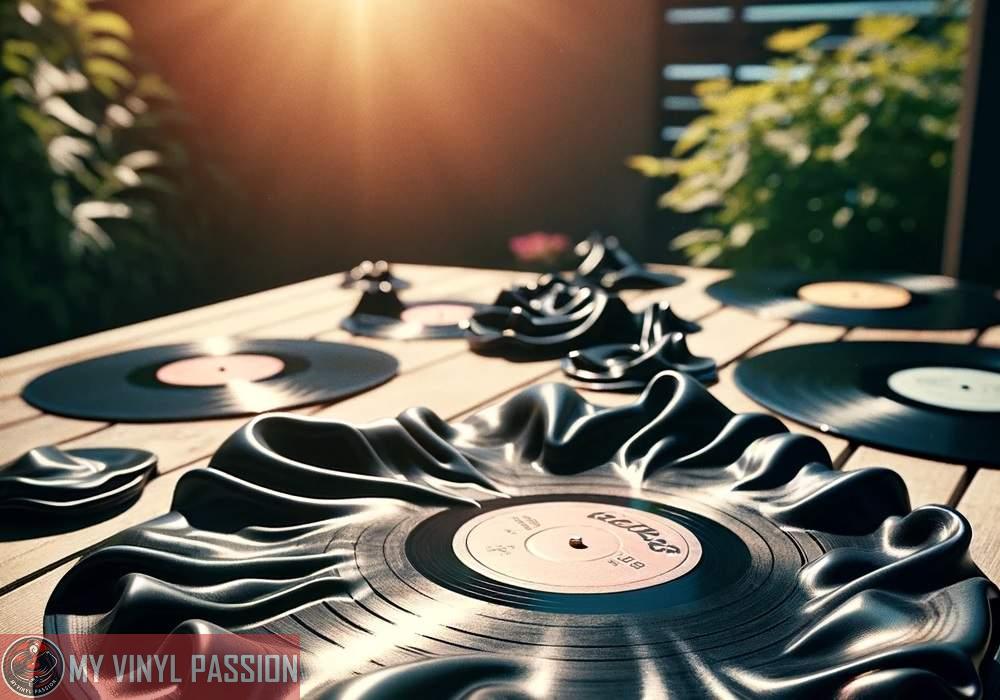Vinyl records, a medium cherished by collectors and audiophiles, trace their origins back to the late 19th century.
The evolution of recorded sound began with Thomas Edison’s invention of the phonograph in 1877, which initially used cylindrical records made of tin foil.
It was Emile Berliner’s gramophone that introduced flat discs, the precursor to modern vinyl records, which were made out of shellac in the late 1880s.
Over time, these materials gave way to vinyl, a plastic known for its durability and improved sound quality.
In Summary
Vinyl records date back to the late 19th century, evolving from Thomas Edison’s phonograph and Emile Berliner’s gramophone, with early discs made of shellac.
The 1940s saw a significant improvement in vinyl records with Columbia Records’ introduction of microgroove technology, leading to the popular 33 1/3 RPM LP and 45 RPM single formats.
Initially made from shellac, vinyl records eventually transitioned to using polyvinyl chloride (PVC) in the 1940s, enhancing their durability and sound quality.
As we move through the 20th century, vinyl records became a dominant form of home entertainment. The advent of microgroove technology in the 1940s by Columbia Records changed the landscape immensely.
This innovation allowed for longer playing time and better sound fidelity, leading to the popular 33 1/3 RPM LP (long play) and 45 RPM single formats we are familiar with today. The introduction of these records marked the beginning of vinyl’s golden age, which lasted until the rise of cassette tapes and compact discs.
Vinyl records have experienced a resurgence in popularity in recent years, reminding us of their cultural impact.
Our ongoing fascination with analog sound and the tangible experience of flipping through a vinyl album cover to cover speaks to the enduring legacy of the medium.
While other formats have emerged and fallen by the wayside, the unique appeal of vinyl has ensured that it continues to spin on turntables around the world.
Origins of Vinyl Records
Vinyl records signify a rich cultural history, connecting us to the earlier days of sound recording. We trace their origins back to the early 20th century, where their predecessors were made from shellac and other materials. It wasn’t until the 1940s that polyvinyl chloride became the preferred material, giving birth to the vinyl records we recognize today.
First Appearance
- Year: 1948
- Inventor: Columbia Records
This technological evolution was marked by an increase in durability and fidelity over its shellac counterparts. Initially, vinyl records appeared in the form of the 33 1/3 RPM long-playing (LP) record, which allowed for over 20 minutes of music per side, a significant improvement upon the previous four-minute limits.
Material Composition:
- Primary component: Polyvinyl chloride
- Quality: Improved durability and sound quality
Our experience with vinyl has shown that record collectors often view records not only as listening experiences but also as cultural artefacts. These collectors appreciate the vinyl records as objects within cultural history.
Cultural Impact:
- 1940s-1980s: Height of popularity
- 1990s-present: Resurgence and nostalgia
As we delve into the history of vinyl, it is evident that these records did more than just play music; they became symbols of entire generations. Small record labels played a crucial role in the rise of American music, often remembered for their intense devotion to their artists and genres. Some of these stories and contributions are chronicled in the book “Little Labels–Big Sound”.
The journey of vinyl records is a testament to the changing tides of technology and culture, yet their allure remains timeless.
Development of Phonograph Technology
As we explore the origins of vinyl records, it’s imperative to understand the significant advancements in the recording industry, starting with the invention of the phonograph and leading up to the evolution of vinyl records as a dominant format for audio playback.
Invention of the Phonograph
Thomas Edison introduced the phonograph to the world in 1877, a revolutionary device that could both record and reproduce sound.
Our encounter with recorded sound began with Edison’s use of tinfoil cylinders, which were the phonograph’s initial recording medium. The phonograph’s invention marked a pivotal moment in audio recording history, laying the foundation for future innovations.
Evolution to Vinyl
Moving forward, we saw the progression from tinfoil to wax cylinders, but it was the development of durable, flat discs that set the stage for vinyl records.
The transition to vinyl originated in the 20th century, when these records began to replace shellac and other less durable materials. Vinyl had a crucial advantage with its longer playback time and improved sound fidelity compared to its predecessors, as highlighted in Vinyl: A history of the analogue record.
This shift not only shaped the listening habits of many but also steered the phonographic technology toward modernity.
The Rise of Vinyl Records
In our exploration of the vinyl record’s history, we find a tale of innovation and cultural impact. Our narrative begins with the medium’s zenith and winds through its extensive reach in production and distribution.
Golden Age of Vinyl
Mid-20th Century Highlights:
- Dominance in the music industry.
- Introduction of LPs (Long Play) and 45 RPM singles.
During the Golden Age of Vinyl, from the 1950s to the 1970s, we witnessed vinyl records becoming the quintessential format for commercial music distribution.
The introduction of 33 1/3 RPM LP records allowed for albums with longer playtime, revolutionizing how we consume music. Alongside, the 45 RPM singles made single-track music widely accessible.
Mass Production and Distribution
Advancements and Accessibility:
- Economies of scale in manufacturing.
- Global access to musical works.
With mass production capabilities hitting their stride, vinyl records became the heartbeat of global music culture. Thanks to manufacturing advancements, we could share iconic albums across continents.
This period saw music transcending physical and cultural boundaries, turning vinyl into a universal language of artistic expression.
Design and Manufacturing
Vinyl records represent a blend of artistry and technical precision. We explore the materials and processes that transform simple compounds into the cherished records collectors and audiophiles treasure.
Materials Used
The primary material we use in the manufacture of vinyl records is polyvinyl chloride (PVC), a versatile plastic that provides the necessary durability and fidelity.
Compounds added to the PVC provide the rigidity and grooved surface necessary to maintain the intricate sound patterns.
- PVC: The foundation of the record’s structure
- Plasticizers: Added for flexibility
- Stabilizers: Employed to prevent degradation
- Carbon black: Sometimes incorporated to give records their traditional color
Manufacturing Process
The process of creating a vinyl record is both intricate and precise.
- Master Recording: We start with a master recording, which is transferred onto a lacquer-coated aluminum disc.
- Electroplating: This lacquer disc undergoes electroplating to create a stamper, which will press the grooves into the vinyl.
- Extrusion: PVC pellets are then melted and extruded to form the ‘biscuit’ that becomes the record.
- Molding: The stamper presses into the heated vinyl ‘biscuit’ with the application of heat and hydraulic pressure, etching the grooves into the record.
- Cooling: After pressing, the record cools down to solidify its shape and grooves.
During this process, consistency and precision are crucial to preserving the audio quality. Each step is closely monitored to ensure the final product meets our high standards.
Cultural Impact
Vinyl records have significantly shaped both the music industry and the social landscape since their inception. They not only influenced how music was distributed and consumed but also played a pivotal role in cultural movements and social gatherings.
Music Industry Influence
The advent of vinyl records marked a revolution in music accessibility, changing the game for artists, record labels, and consumers. For instance, groundbreaking albums pressed on vinyl connected artists with fans globally, turning local sounds into international movements.
- Promoted Artist Fanbase Growth: Before the digital age, vinyl was a primary medium for fans to enjoy music, contributing vastly to the growth of an artist’s fanbase and reputation.
- Changed Music Production: Recording techniques were often tailored to the limitations and strengths of vinyl, which influenced not only sound quality but also album structure.
Social Significance
Vinyl records took on a symbolic meaning that extended beyond mere music playback—they became a statement of identity and cultural belonging.
- Physical Medium as Social Artifact: Vinyl as a collectible item allowed individuals to express their personalities through their collections and contributed to the formation of record clubs and social events oriented around music sharing.
- Backbone of DJ Culture: DJs used vinyl records to pioneer the art of mixing and scratching, leading to new music genres and the rise of club culture. The tactile nature of vinyl offered a unique, hands-on experience that became central to DJ performances.
Vinyl records, through their presence and persistent relevance, deeply affected our cultural identity and the way we experience music.
Technological Advancements
In our examination of vinyl records’ origins, we’ve observed remarkable technological progressions that have critically enhanced the entire listening experience.
Sound Quality Improvements
The evolution of vinyl records saw dramatic improvements in sound fidelity. Initially, records captured audio through mechanical means, which resulted in high levels of noise and distortion.
As electronic recording technologies emerged, we witnessed a significant leap forward in the purity of sound. The introduction of multi-track recording allowed us to isolate and optimize individual audio channels, thereby greatly enriching the sonic texture and depth.
Playback Technology
Alongside sound quality advancements, playback technology also evolved. The gramophone, vinyl’s earliest companion, utilized a needle that directly vibrated to produce sound.
With the advent of the electric turntable, we enhanced precision and consistency in playback speed, ensuring a more accurate reproduction of recordings. Improvements in stylus design and the development of high-fidelity sound systems have allowed us to enjoy vinyl with greater clarity and detail.
Vinyl Records in Modern Times
In recent years, vinyl records have witnessed a significant revival, becoming both a cultural and audio trend. This resurgence is underpinned by tangible audio experiences and the growth of vinyl as a collector’s item.
Resurgence in Popularity
Vinyl records have seen a remarkable 223 percent increase in sales, highlighting a renewed interest in the format. This upswing reflects a desire for tangible music formats amidst the prevalence of digital streaming.
Studies suggest that music enthusiasts appreciate the richer sound quality and tactile nature of vinyl. Certain new releases are now being produced in vinyl format, providing the traditional analog experience with contemporary music.
Modern Collecting
Collecting vinyl records has evolved into a dedicated hobby for many. Social aspects, such as sharing one’s collection with friends, play a significant role in this modern phenomenon. Retailers like Best Buy recognize this trend by stocking a select range of vinyl albums.
Collectors often seek authentic material in their pursuit of both classic and new releases, which has spurred a notable market for vinyl records in the 21st century.
Future of Vinyl Records
In observing the trajectory of vinyl records, we recognize a growing fascination with their tangible qualities.
Despite living in an age of digital streaming, vinyl offers a unique experience that appeals to audiophiles and collectors alike. This revival is not a temporary trend as we’ve seen a consistent increase in vinyl sales over the past decade.
Key Predictions for Vinyl Records:
- Production Innovations: We will likely see advancements in manufacturing processes to enhance the sound quality and durability of vinyl records.
- Sustainability Focus: There will be a push towards using sustainable materials for both the records and their packaging.
Market Trends:
- Collectibility: Vinyl will continue to be prized as collectibles, driving special editions and limited pressings.
- Niche Markets: Enthusiasts will sustain a market for vinyl, ensuring a steady release of new titles alongside reissues of classic albums.
Challenges & Solutions:
| Challenge | Potential Solution |
|---|---|
| Environmental concerns of PVC | Adoption of eco-friendly materials |
| Limited pressing plant capacities | Investment in more pressing facilities |
| High cost compared to digital music | Enhanced experience justifying the premium price |
With ongoing interest from younger generations and the special place vinyl holds for many music lovers, we are confident in the enduring presence of vinyl records in our musical landscape.
The future appears bright for this classic format, maintaining its status as a beloved medium for experiencing music.
FAQs
When were vinyl records first introduced?
Vinyl records were first introduced in 1948 by Columbia Records. This marked the transition from earlier shellac-based records to vinyl.
Who invented the technology behind vinyl records?
The technology that led to vinyl records evolved from Thomas Edison’s invention of the phonograph in 1877, followed by Emile Berliner’s development of the gramophone in the late 1880s.
What material were records made of before vinyl?
Before vinyl, records were primarily made of shellac, a material that was more brittle and offered shorter playback time compared to vinyl.
Why did the music industry switch to vinyl from earlier materials?
The music industry switched to vinyl because it offered greater durability and allowed for longer playing times and better sound fidelity than shellac.
What were the first types of vinyl records available?
The first types of vinyl records available were the 33 1/3 RPM LP (long play) records and the 45 RPM singles, which were introduced by Columbia Records and RCA Victor, respectively.
